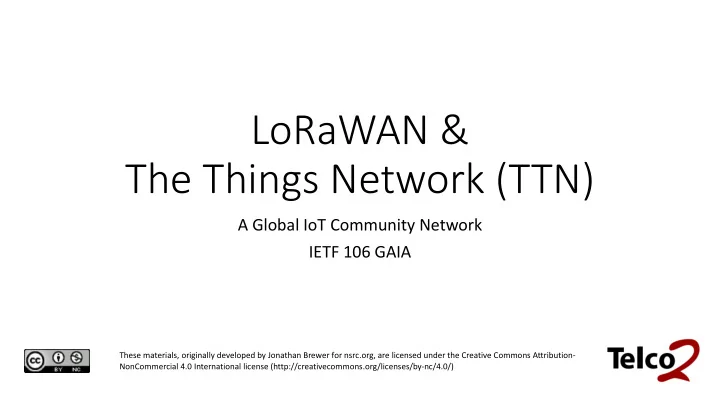

LoRaWAN & The Things Network (TTN) A Global IoT Community Network IETF 106 GAIA These materials, originally developed by Jonathan Brewer for nsrc.org, are licensed under the Creative Commons Attribution- NonCommercial 4.0 International license (http://creativecommons.org/licenses/by-nc/4.0/)
What is LoRa? • PHY Radio Protocol for the Internet of Things • Operates in sub-GHz ISM bands worldwide • 433, 470-510, 779-787, 863-870, 902-928 MHz • Derivative of Chirp Spread Spectrum • Proprietary to Semtech • Designed for long range, low power, low data rate • Star topology (not mesh or p2p) • 250 bits per second to 22 kilobits per second • depending on channel width & modulation
What is LoRaWAN? • Wireless Network for the Internet of Things • Open, non-proprietary standard • Adds addressing, mobility & localisation to LoRa • Multiple base stations can receive & process packets • Adaptive data rate scheme to improve performance • Multiple levels of encryption (Network & Application) • Supports time slot scheduling of device transmission
LoRaWAN Entities Gateway End Device Network Server Gateway End Device End Device End Device End Device Application Application
LoRaWAN Architecture Overview • Based on RFC 8376 (Ed. Stephen Farrell) • https://datatracker.ietf.org/doc/rfc8376/ • Verbatim text is italicised • Important terms are bolded • RFC8376 detail ends with OTA join process
LoRaWAN: End Device • a LoRa client device, sometimes called a mote • Also sometimes called a node • Communicates with gateways • And never with other motes or nodes • Has a globally unique identifier called DevEUI • In the format of an IEEE EUI64 (64 bit) • Has a network unique identifier called DevAddr • Only network unique 32 bit
LoRaWAN: End Device
LoRaWAN: Device Classes ALOHA based, with comms always initiated by end Class A device. After transmit, device listens for replies or (lowest power) network control for a short time period. Class B Supports Class A transmissions, plus periodically (deterministic listens for network messages on a schedule. Still downlink) suitable for battery use, but less e ffi cient than Class A. Class C Supports Class A transmissions, plus actively listens (lowest latency) for network messages. Not suitable for battery use.
LoRaWAN: Gateway • A radio on the infrastructure side • Sometimes called a concentrator or base-station • Communicates with end devices via LoRaWAN • Communicates with a network server via TCP/IP • Can co-exist on multi-protocol base stations • Typically runs a software instance per gateway radio
LoRaWAN: Gateway
LoRaWAN: Network Server (NS) • The Network Server terminates LoRaWAN MAC layer • for End-Devices connected to the network • It is the centre of the star topology • The Network Server decides: • which Gateway will talk to which End Device • what data rates will be used by End Devices
LoRaWAN: Network Server (NS)
LoRaWAN: Join Server (JS) • Server on the Internet Side of a Network Server • Processes join requests from end-devices • End devices cannot be used without joining a network • Often combined with the Network Server
LoRaWAN: Uplink Message • Communications from end devices to the network server or application • Received via one or more gateways • Uplink Messages received by more than one gateways are de- duplicated by the Network Server
LoRaWAN: Downlink Message • Communications from network server or application • via one gateway • to a single end-device • or a group of end devices • Network Server decides which gateway is in the best place to send a downlink message to a particular device.
LoRaWAN: Application • Application layer code running on the end device • Application code running “behind” the network server • Most end devices will run only one application • Identified by a registered IEEE EUI64 value ( AppEUI ) • “Applications” typically run on Network Servers • Provide for device management • Route data to external applications • Misleading name: Could be called application router
LoRaWAN: Encryption • All payloads are encrypted • No possibility for attackers to read payloads • No possibility for network operator to read payloads • and have data integrity • No possibility for changing data in flight • No possibility for intercepting & replaying data • MAC commands are protected (except frame options) • No possibility for attackers to read metadata
LoRaWAN: Pre-Joined Devices ( ABP ABP ) • End devices must have two symmetric session keys • Devices are personalised with AES 128-bit keys • Network Session Key ( NwkSKey ) • Known only by the network operator • Protects network metadata • Application Session Key ( AppSKey ) • Common to all End Devices using an Application • Known only to the Application Operator
LoRaWAN: Over the Air Join ( OT OTAA ) • End devices must have two symmetric keys • Network Session Key ( NwkSKey ) • Application Key ( AppKey ) • Different from the AppSKey • Unique to every End Device • Device sends DevEUI , AppEUI , and AppKey • Network sends data allowing Dev to derive AppSkey and NwkSKey (then proceed as a pre-joined device) Diagram from: https://www.jaguar-network.com/en/news/lorawan-in-a-nutshell-2-internet-of-things-iot/
What is The Things Network (TTN)? • TTN is a free, distributed, LoRaWAN platform • It provides a Network Server, Join Server, and Application Servers • Web platform allows gateway owners to create coverage • And application owners to register devices • All gateways process all traffic! • TTN helps communities organise & communicate too.
Where is The Things Network (TTN)?
TTN Console Views
TTN Integrations
LoRaWAN & TTN Device Ecosystem Devices from https://lpwanmarket.com/
Recommend
More recommend